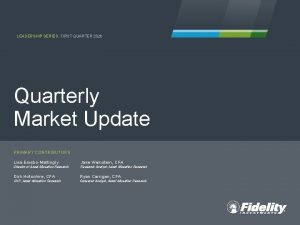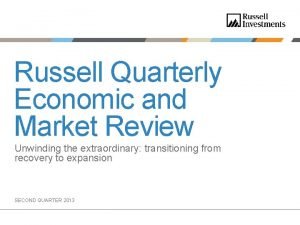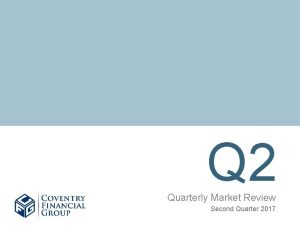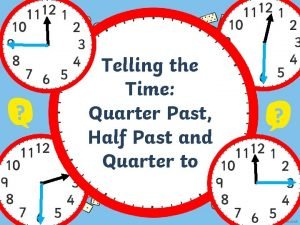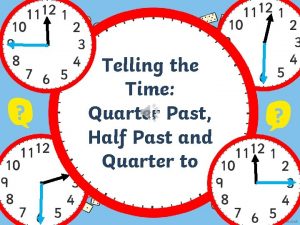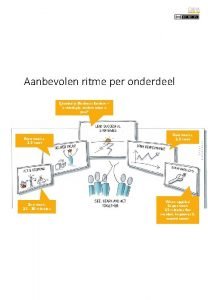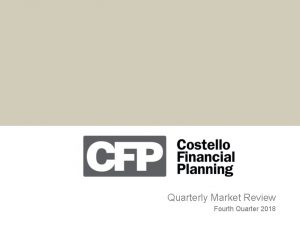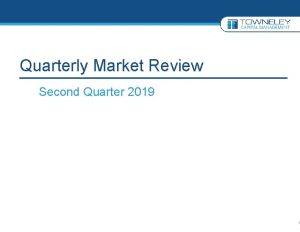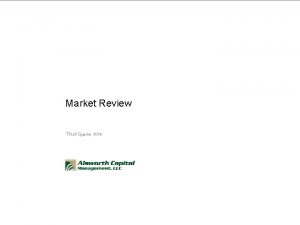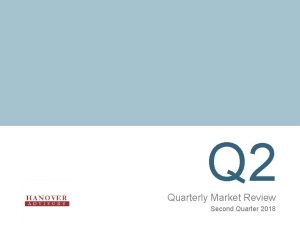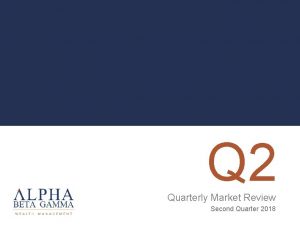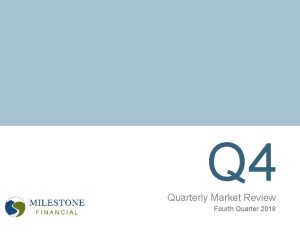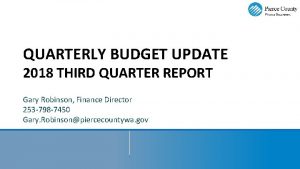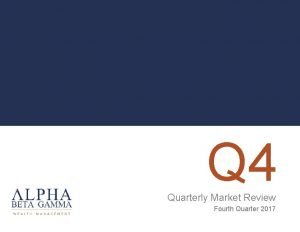Q 3 Quarterly Market Review Third Quarter 2018


















- Slides: 18

Q 3 Quarterly Market Review Third Quarter 2018

Quarterly Market Review Third Quarter 2018 Overview: This report features world capital market performance and a timeline of events for the past quarter. It begins with a global overview, then features the returns of stock and bond asset classes in the US and international markets. Market Summary The report also illustrates the impact of globally diversified portfolios and features a quarterly topic. US Stocks World Stock Market Performance World Asset Classes International Developed Stocks Emerging Markets Stocks Select Country Performance Select Currency Performance vs. US Dollar Real Estate Investment Trusts (REITs) Commodities Fixed Income Impact of Diversification Quarterly Topic: Total Cost of Fund Ownership 2

Market Summary Index Returns Past performance is not a guarantee of future results. Indices are not available for direct investment. Index performance does not reflect the expenses associated with the management of an actual portfolio. Market segment (index representation) as follows: US Stock Market (Russell 3000 Index), International Developed Stocks (MSCI World ex USA Index [net div. ]), Emerging Markets (MSCI Emerging Markets Index [net div. ]), Global Real Estate (S&P Global REIT Index [net div. ]), US Bond Market (Bloomberg Barclays US Aggregate Bond Index), and Global Bond Market ex US (Bloomberg Barclays Global Aggregate ex-USD Bond Index [hedged to USD]). S&P data © 2018 S&P Dow Jones Indices LLC, a division of S&P Global. All rights reserved. Frank Russell Company is the source and owner of the trademarks, service marks, and copyrights related to the Russell Indexes. MSCI data © MSCI 2018, all rights reserved. Bloomberg Barclays data provided by Bloomberg. FTSE fixed income © 2018 FTSE Fixed Income LLC, all rights reserved. 3

World Stock Market Performance MSCI All Country World Index with selected headlines from Q 3 2018 “Japan, EU Sign Trade “Nasdaq Crosses “Rising US Consumer Deal: ‘We Stand 8000 Threshold Prices Are Eroding Together against for First Time” Wage Gains” Protectionism’” “US Economy Grew “Resignations Over “Greece’s Bailouts at 4. 1% Rate in May’s Brexit Plan End, but Its Second Quarter” Throw UK Prospects Still Government into Look Grim” Turmoil” “Deficit Projected to Top $1 Trillion Starting Next Year” July “US Jobless Claims Hit Lowest Level since 1969” “US Pressures China with Punitive Trade, Defense Measures” “Youth Unemployment Hits 52 -Year Low” Aug “China’s Trade Surplus with US Hits New Record” “Fed Raises Interest Rates, Signals One More Increase This Year” “US Consumer Confidence Hits 18 -Year High” “US Factory Sector Clocks Strongest Growth in 14 Years” Sep These headlines are not offered to explain market returns. Instead, they serve as a reminder that investors should view daily events from a long-term perspective and avoid making investment decisions based solely on the news. Graph Source: MSCI ACWI Index [net div. ]. MSCI data © MSCI 2018, all rights reserved. It is not possible to invest directly in an index. Performance does not reflect the expenses associated with management of an actual portfolio. Past performance is not a guarantee of future results. 4

World Stock Market Performance MSCI All Country World Index with selected headlines from past 12 months Short Term (Q 4 2017–Q 3 2018) “US Economy Reaches Its Potential Output for First Time in Decade” 270 260 250 “New-Home Sales Growth Surges to 25 -Year High” “Nasdaq Crests 7000 as Tech Giants Roar Into 2018” “Congress Passes Mammoth Spending Bill, Averts Shutdown” “Trump Pulls US Out of Iran Deal” 240 230 “Trump Signs Sweeping Tax Overhaul Into Law” “US Factory Activity Hits 13 -Year High” 220 “US Imposes New Tariffs, Ramping Up 'America First' Trade Policy” “Yield on 10 -Year US Government Bond Hits 3% for First Time in Years” 210 200 190 Long Term 180 170 160 150 сен-2017 2005 “Profits Surge at Big US Firms” “Nasdaq Crosses 8000 Threshold for First Time” “Inflation Rate Hits Six-Year High in May” “US Jobless Claims Hit Lowest Level since 1969” “Fed Raises Interest Rates, Signals One More Increase This Year” Last 12 months (2000–Q 3 2018) 300 250 200 150 100 50 0 2000 “China’s Trade Surplus with US Hits New Record” “US, China Tariffs Hit American-Made Products from Chips to Cars” 2010 2015 дек-2017 мар-2018 июн-2018 These headlines are not offered to explain market returns. Instead, they serve as a reminder that investors should view daily events from a long-term perspective and avoid making investment decisions based solely on the news. Graph Source: MSCI ACWI Index [net div. ]. MSCI data © MSCI 2018, all rights reserved. It is not possible to invest directly in an index. Performance does not reflect the expenses associated with management of an actual portfolio. Past performance is not a guarantee of future results. сен-2018 5

World Asset Classes Third Quarter 2018 Index Returns (%) Looking at broad market indices, the US outperformed non-US developed and emerging markets during the quarter. Small caps underperformed large caps in the US, non-US developed, and emerging markets. The value effect was positive in emerging markets but negative in the US and non-US developed markets. REIT indices underperformed equity market indices in both the US and non-US developed markets. S&P 500 Index 7, 71 Russell 1000 Index 7, 42 Russell 3000 Index 7, 12 Russell 1000 Value Index 5, 70 Russell 2000 Index 3, 58 MSCI Emerging Markets Value Index (net div. ) 3, 44 Russell 2000 Value Index 1, 60 MSCI World ex USA Index (net div. ) 1, 31 MSCI World ex USA Value Index (net div. ) 1, 15 Dow Jones US Select REIT Index 0, 72 MSCI All Country World ex USA Index (net div. ) 0, 71 One-Month US Treasury Bills 0, 48 Bloomberg Barclays US Aggregate Bond Index 0, 02 MSCI World ex USA Small Cap Index (net div. ) -0, 85 MSCI Emerging Markets Index (net div. ) -1, 09 S&P Global ex US REIT Index (net div. ) MSCI Emerging Markets Small Cap Index (net div. ) -1, 41 -4, 21 Past performance is not a guarantee of future results. Indices are not available for direct investment. Index performance does not reflect the expenses associated with the management of an actual portfolio. The S&P data is provided by Standard & Poor's Index Services Group. Frank Russell Company is the source and owner of the trademarks, service marks, and copyrights related to the Russell Indexes. MSCI data © MSCI 2018, all rights reserved. Dow Jones data © 2018 S&P Dow Jones Indices LLC, a division of S&P Global. All rights reserved. S&P data © 2018 S&P Dow Jones Indices LLC, a division of S&P Global. All rights reserved. Bloomberg Barclays data provided by Bloomberg. Treasury bills © Stocks, Bonds, Bills, and Inflation Yearbook™, Ibbotson Associates, Chicago (annually updated work by Roger G. Ibbotson and Rex A. Sinquefield). 6

US Stocks Third Quarter 2018 Index Returns The US equity market posted a positive return, outperforming both non-US developed and emerging markets. Value underperformed growth in the US across large and small cap stocks. Ranked Returns for the Quarter (%) Large Growth 9, 17 Large Cap 7, 42 Marketwide Small caps underperformed large caps in the US. 7, 12 Large Value 5, 70 Small Growth 5, 52 Small Cap Small Value 3, 58 1, 60 World Market Capitalization—US 55% US Market $29. 7 trillion Past performance is not a guarantee of future results. Indices are not available for direct investment. Index performance does not reflect the expenses associated with the management of an actual portfolio. Market segment (index representation) as follows: Marketwide (Russell 3000 Index), Large Cap (Russell 1000 Index), Large Cap Value (Russell 1000 Value Index), Large Cap Growth (Russell 1000 Growth Index), Small Cap (Russell 2000 Index), Small Cap Value (Russell 2000 Value Index), and Small Cap Growth (Russell 2000 Growth Index). World Market Cap represented by Russell 3000 Index, MSCI World ex USA IMI Index, and MSCI Emerging Markets IMI Index. Russell 3000 Index is used as the proxy for the US market. Frank Russell Company is the source and owner of the trademarks, service marks, and copyrights related to the Russell Indexes. MSCI data © MSCI 2018, all rights reserved. 7

International Developed Stocks Third Quarter 2018 Index Returns In US dollar terms, developed markets outside the US underperformed the US but outperformed emerging markets during the quarter. Large cap value stocks underperformed large cap growth stocks in non-US developed markets; however, small cap value outperformed small cap growth. Small caps underperformed large caps in non-US developed markets. Ranked Returns (%) Local currency 2, 14 Growth 1, 46 2, 06 Large Cap 1, 31 1, 98 Value Small Cap US currency 1, 15 0, 04 -0, 85 World Market Capitalization—International Developed 34% International Developed Market $18. 6 trillion Past performance is not a guarantee of future results. Indices are not available for direct investment. Index performance does not reflect the expenses associated with the management of an actual portfolio. Market segment (index representation) as follows: Large Cap (MSCI World ex USA Index), Small Cap (MSCI World ex USA Small Cap Index), Value (MSCI World ex USA Value Index), and Growth (MSCI World ex USA Growth Index). All index returns are net of withholding tax on dividends. World Market Cap represented by Russell 3000 Index, MSCI World ex USA IMI Index, and MSCI Emerging Markets IMI Index. MSCI World ex USA IMI Index is used as the proxy for the International Developed market. MSCI data © MSCI 2018, all rights reserved. Frank Russell Company is the source and owner of the trademarks, service marks, and copyrights related to the Russell Indexes. 8

Emerging Markets Stocks Third Quarter 2018 Index Returns In US dollar terms, emerging markets posted negative returns for the quarter, underperforming developed markets including the US. The value effect was positive, particularly in large caps in emerging markets. Ranked Returns (%) Local currency 4, 53 Value 3, 44 -0, 04 Large Cap -1, 09 Small caps underperformed large caps. -2, 88 Small Cap Growth US currency -4, 21 -4, 36 -5, 38 World Market Capitalization—Emerging Markets 11% Emerging Markets $5. 8 trillion Past performance is not a guarantee of future results. Indices are not available for direct investment. Index performance does not reflect the expenses associated with the management of an actual portfolio. Market segment (index representation) as follows: Large Cap (MSCI Emerging Markets Index), Small Cap (MSCI Emerging Markets Small Cap Index), Value (MSCI Emerging Markets Value Index), and Growth (MSCI Emerging Markets Growth Index). All index returns are net of withholding tax on dividends. World Market Cap represented by Russell 3000 Index, MSCI World ex USA IMI Index, and MSCI Emerging Markets IMI Index used as the proxy for the emerging market portion of the market. MSCI data © MSCI 2018, all rights reserved. Frank Russell Company is the source and owner of the trademarks, service marks, and copyrights related to the Russell Indexes. 9

Select Country Performance Third Quarter 2018 Index Returns In US dollar terms, Israel, the US, and Sweden recorded the highest country performance in developed markets, while Ireland Belgium posted the lowest returns for the quarter. In emerging markets, Thailand Qatar recorded the highest country performance, while Turkey, Greece, Egypt, and China posted the lowest performance. Ranked Developed Markets Returns (%) Israel US Sweden Switzerland Norway Japan France Finland Singapore New Zealand Denmark Austria Canada Germany -0, 59 Australia -0, 91 Netherlands -1, 46 Hong Kong -1, 54 Portugal -1, 74 UK -2, 00 -2, 21 Spain Italy -3, 59 Belgium -4, 19 Ireland -5, 42 Ranked Emerging Markets Returns (%) 8, 53 6, 94 6, 44 6, 35 6, 13 2, 97 2, 48 1, 96 1, 95 1, 90 1, 34 0, 73 0, 59 Thailand Qatar Poland Mexico Russia Brazil Taiwan Hungary Czech Republic Malaysia UAE Korea Indonesia Philippines Chile Peru Colombia India Pakistan South Africa China Egypt Greece Turkey -20, 89 14, 91 11, 64 9, 31 7, 49 5, 62 5, 08 4, 41 4, 07 3, 48 3, 22 2, 54 0, 79 0, 39 0, 15 -1, 60 -2, 18 -3, 73 -4, 30 -4, 34 -6, 93 -7, 65 -10, 88 -13, 36 Past performance is not a guarantee of future results. Indices are not available for direct investment. Index performance does not reflect the expenses associated with the management of an actual portfolio. Country performance based on respective indices in the MSCI World ex US IMI Index (for developed markets), MSCI USA IMI Index (for US), and MSCI Emerging Markets IMI Index. All returns in USD and net of withholding tax on dividends. MSCI data © MSCI 2018, all rights reserved. UAE and Qatar have been reclassified as emerging markets by MSCI, effective May 2014. 10

Select Currency Performance vs. US Dollar Third Quarter 2018 In developed markets, currencies recorded mixed results vs. the US dollar. The Canadian dollar and the Swiss franc appreciated over 1. 5% vs. the US dollar, but the Japanese yen and Australian and New Zealand dollars all each depreciated more than 2%. In emerging markets, most currencies depreciated against the US dollar. The Turkish lira fell over 20%, but the Mexican Peso appreciated more than 5%. Ranked Developed Markets (%) Ranked Emerging Markets (%) Canadian dollar (CAD) 1, 77 Swiss franc (CHF) 1, 65 Israel shekel (ILS) 0, 67 Swedish krona (SEK) 0, 59 Hong Kong dollar (HKD) 0, 26 Norwegian krone (NOK) 0, 09 Singapore dollar (SGD) -0, 21 Euro (EUR) -0, 52 Danish krone (DKK) -0, 61 British pound (GBP) -1, 23 Australian dollar (AUD) -2, 07 New Zealand dollar (NZD) -2, 08 Japanese yen (JPY) -2, 48 Mexican peso (MXN) 5, 12 Thailand baht (THB) 2, 44 Poland new zloty (PLN) 1, 57 Hungary forint (HUF) 1, 23 South Korean won (KRW) 0, 47 Czech koruna (CZK) 0, 38 -0, 15 Taiwanese NT dollar (TWD) Egyptian pound (EGP) -0, 17 Peru new sol (PEN) -0, 73 Colombian peso (COP) -1, 09 Philippine peso (PHP) -1, 23 Chilean peso (CLP) Pakistani rupee (PKR) Malaysian ringgit (MYR) South African rand (ZAR) -1, 30 -2, 20 -2, 39 -3, 14 Brazilian real (BRL) -3, 66 Chinese yuan (CNY) -3, 71 Indonesia rupiah (IDR) -3, 84 Russian ruble (RUB) -4, 26 Indian rupee (INR) -5, 48 Turkish new lira (TRY) -23, 74 Past performance is not a guarantee of future results. Indices are not available for direct investment. Index performance does not reflect the expenses associated with the management of an actual portfolio. MSCI data © MSCI 2018, all rights reserved. 11

Real Estate Investment Trusts (REITs) Third Quarter 2018 Index Returns US real estate investment trusts outperformed non-US REITs in US dollar terms. Ranked Returns (%) US REITs Global REITs (ex US) 0, 72 -1, 41 Total Value of REIT Stocks 41% World ex US $459 billion 240 REITs (21 other countries) 59% US $656 billion 98 REITs Past performance is not a guarantee of future results. Indices are not available for direct investment. Index performance does not reflect the expenses associated with the management of an actual portfolio. Number of REIT stocks and total value based on the two indices. All index returns are net of withholding tax on dividends. Total value of REIT stocks represented by Dow Jones US Select REIT Index and the S&P Global ex US REIT Index. Dow Jones US Select REIT Index used as proxy for the US market, and S&P Global ex US REIT Index used as proxy for the World ex US market. Dow Jones data © 2018 S&P Dow Jones Indices LLC, a division of S&P Global. All rights reserved. S&P data © 2018 S&P Dow Jones Indices LLC, a division of S&P Global. All rights reserved. 12

Commodities Third Quarter 2018 Index Returns The Bloomberg Commodity Index Total Return declined 2. 02% in the third quarter. Ranked Returns for Individual Commodities (%) Heating oil The energy complex led performance. Heating oil gained 5. 63%, and Brent oil returned 5. 21%. Nickel, the worst-performing commodity, declined 16. 05%. Sugar lost 14. 50%, and coffee fell 13. 48%. 5, 63 Brent crude oil 5, 21 Unleaded gas 4, 92 Live cattle 4, 55 WTI crude oil 2, 73 Natural gas 2, 34 Kansas wheat 0, 03 Lean hogs -1, 36 Wheat -2, 24 Soybean oil -2, 52 Aluminum -3, 03 Soybeans -3, 92 Corn -4, 51 Gold -5, 49 Copper -6, 14 Soybean meal -6, 34 Zinc -6, 69 Cotton -9, 00 Silver Coffee Sugar Nickel -9, 75 -13, 48 -14, 50 -16, 05 Past performance is not a guarantee of future results. Index is not available for direct investment. Index performance does not reflect the expenses associated with the management of an actual portfolio. Commodities returns represent the return of the Bloomberg Commodity Total Return Index. Individual commodities are sub-index values of the Bloomberg Commodity Total Return Index. Data provided by Bloomberg. 13

Fixed Income Third Quarter 2018 Index Returns Interest rates increased in the US during the third quarter. The yield on the 5 -year Treasury note rose 21 basis points (bps), ending at 2. 94%. The yield on the 10 -year Treasury note increased 20 bps to 3. 05%. The 30 -year Treasury bond yield rose 21 bps to 3. 19%. On the short end of the yield curve, the 1 -month Treasury bill yield increased 35 bps to 2. 12%, while the 1 -year Treasury bill yield rose 26 bps to 2. 59%. The 2 -year Treasury note yield finished at 2. 81% after an increase of 29 bps. US Treasury Yield Curve (%) Bond Yields across Issuers (%) 4, 00 4, 20 43371 3, 00 43280 43007 3, 05 3, 41 3, 59 Municipals AAA-AA Corporates 2, 00 1, 00 0, 00 1 Yr 5 Yr 10 Yr 30 Yr 10 -Year US Treasury A-BBB Corporates In terms of total return, short-term corporate bonds gained 0. 71%, while intermediate-term corporates returned 0. 80%. Short-term municipal bonds declined 0. 11%, while intermediate-term munis dipped 0. 06%. Revenue bonds (‒ 0. 16%) performed in line with general obligation bonds (‒ 0. 14%). One basis point equals 0. 01%. Past performance is not a guarantee of future results. Indices are not available for direct investment. Index performance does not reflect the expenses associated with the management of an actual portfolio. Yield curve data from Federal Reserve. State and local bonds are from the S&P National AMT-Free Municipal Bond Index. AAA-AA Corporates represent the Bank of America Merrill Lynch US Corporates, AA-AAA rated. A-BBB Corporates represent the Bank of America Merrill Lynch US Corporates, BBB-A rated. Bloomberg Barclays data provided by Bloomberg. US long-term bonds, bills, inflation, and fixed income factor data © Stocks, Bonds, Bills, and Inflation (SBBI) Yearbook™, Ibbotson Associates, Chicago (annually updated work by Roger G. Ibbotson and Rex A. Sinquefield). FTSE fixed income indices © 2018 FTSE Fixed Income LLC, all rights reserved. ICE Bof. AML index data © 2018 ICE Data Indices, LLC. 14

Impact of Diversification Third Quarter 2018 Index Returns These portfolios illustrate the performance of different global stock/bond mixes and highlight the benefits of diversification. Mixes with larger allocations to stocks are considered riskier but have higher expected returns over time. Ranked Returns (%) 4, 40 100% Stocks 3, 41 75/25 2, 43 50/50 1, 45 25/75 100% Treasury Bills 0, 48 Growth of Wealth: The Relationship between Risk and Return $120 000 Stock/Bond Mix 100% Stocks $100 000 $80 000 75/25 $60 000 50/50 $40 000 25/75 100% Treasury Bills $20 000 $0 12. 1988 12. 1993 12. 1998 12. 2003 12. 2008 12. 2013 9/2018 1. STDEV (standard deviation) is a measure of the variation or dispersion of a set of data points. Standard deviations are often used to quantify the historical return volatility of a security or portfolio. Diversification does not eliminate the risk of market loss. Past performance is not a guarantee of future results. Indices are not available for direct investment. Index performance does not reflect expenses associated with the management of an actual portfolio. Asset allocations and the hypothetical index portfolio returns are for illustrative purposes only and do not represent actual performance. Global Stocks represented by MSCI All Country World Index (gross div. ) and Treasury Bills represented by US One-Month Treasury Bills. Globally diversified allocations rebalanced monthly, no withdrawals. Data © MSCI 2018, all rights reserved. Treasury bills © Stocks, Bonds, Bills, and Inflation Yearbook™, Ibbotson Associates, Chicago (annually updated work by Roger G. Ibbotson and Rex A. Sinquefield). 15

Total Cost of Ownership Third Quarter 2018 Costs matter. Whether you’re buying a car or selecting an investment strategy, the costs you expect to pay are likely to be an important factor in making any major financial decision. per year on every $1 million invested. As Exhibit 2 helps to illustrate, those dollars can really add up over time. Exhibit 1. High Costs Can Reduce Performance, Equity Fund Winners and Losers Based on Expense Ratios (%) People rely on a lot of different information about costs to help inform these decisions. When you buy a car, for example, the sticker price indicates approximately how much you can expect to pay for the car itself. But the costs of car ownership do not end there. Taxes, insurance, fuel, routine maintenance, and unexpected repairs are also important considerations in the overall cost of a car. Some of these costs are easily observed, while others are more difficult to assess. Similarly, when investing in mutual funds, different variables need to be considered to evaluate how cost‑effective a strategy may be for a particular investor. EXPENSE RATIOS Mutual funds have many costs, all of which affect the net return to investors. One easily observable cost is the expense ratio. Like the sticker price of a car, the expense ratio tells you a lot about what you can expect to pay for an investment strategy. Expense ratios strongly influence fund selection for many investors, and it’s easy to see why. Exhibit 1 illustrates the outperformance rate, or the percentage of funds that beat their category index, for active equity mutual funds over the 15 -year period ending December 31, 2017. To see the link between expense ratio and performance, outperformance rates are shown for quartiles of funds sorted by their expense ratio. As the chart shows, while active funds have mostly lagged indices across the board, the outperformance rate has been inversely related to expense ratio. Just 6% of funds in the highest expense ratio quartile beat their index, compared to 25% for the lowest expense ratio group. This data indicates that a high expense ratio presents a challenging hurdle for funds to overcome, especially over longer time horizons. From the investor’s point of view, an expense ratio of 0. 25% vs. 1. 25% means savings of $10, 000 Average Expense Ratio (%) 0. 83 1. 14 1. 38 1. 93 Low Med. High The sample includes funds at the beginning of the 15 -year period ending December 31, 2017. Funds are sorted into quartiles within their category based on average expense ratio over the sample period. The chart shows the percentage of winner and loser funds by expense ratio quartile; winners are funds that survived and outperformed their respective Morningstar category benchmark, and losers are funds that either did not survive or did not outperform their respective Morningstar category benchmark. US-domiciled open-end mutual fund data is from Morningstar and Center for Research in Security Prices (CRSP) from the University of Chicago. Equity fund sample includes the Morningstar historical categories: Diversified Emerging Markets, Europe Stock, Foreign Large Blend, Foreign Large Growth, Foreign Large Value, Foreign Small/Mid Blend, Foreign Small/Mid Growth, Foreign Small/Mid Value, Japan Stock, Large Blend, Large Growth, Large Value, Mid-Cap Blend, Mid-Cap Value, Miscellaneous Region, Pacific/Asia ex-Japan Stock, Small Blend, Small Growth, Small Value, and World Stock. For additional information regarding the Morningstar historical categories, please see “The Morningstar Category Classifications” at morningstardirect. morningstar. com/clientcomm/Morningstar_Categories_US_April_2016. pdf. Index funds and fund-of-funds are excluded from the sample. The return, expense ratio, and turnover for funds with multiple share classes are taken as the asset-weighted average of the individual share class observations. For additional methodology, please refer to Dimensional Fund Advisors’ brochure, Mutual Fund Landscape 2018. Past performance is no guarantee of future results. 16

Total Cost of Ownership (continued from page 16) Exhibit 2. Hypothetical Growth of $1 Million at 6%, Less Expenses For illustrative purposes only and not representative of an actual investment. This hypothetical illustration is intended to show the potential impact of higher expense ratios and does not represent any investor’s actual experience. Assumes a starting account balance of $1 million and a 6% compound annual growth rate less expense ratios of 0. 25%, 0. 75%, and 1. 25% applied over a 15 -year time horizon. Performance of a hypothetical investment does not reflect transaction costs, taxes, other potential costs, or returns that any investor would have actually attained and may not reflect the true costs, including management fees of an actual portfolio. Actual results may vary significantly. Changing the assumptions would result in different outcomes. For example, the savings and difference between the ending account balances would be lower if the starting investment amount were lower. GOING BEYOND THE EXPENSE RATIO The poor track record of mutual funds with high expense ratios has led many investors to select mutual funds based on expense ratio alone. However, as with a car’s sticker price, an expense ratio is not an all-encompassing measure of the cost of ownership. Take, for example, index funds, which often rank near the bottom of their peers on expense ratio. Index funds are designed to track or match the components of an index formed by an index provider, such as Russell or MSCI. Important decisions in the investment process, such as which securities to include in the index, are outsourced to an index provider and are not within the fund manager’s discretion. For example, the prescribed reconstitution schedule for an index, which is the process of deleting or adding certain stocks to the index, may cause index funds to buy stocks when buy demand is high and sell stocks when buy demand is low. This price-insensitive buying and selling may be required so that the index fund can stay true to its investment mandate of tracking an underlying index. This can result in suboptimal transaction prices for the index fund and diminished overall returns. In other words, for a given amount of trading (or turnover), the cost per unit of trading may be higher for such a strictly regimented approach to investing. Moreover, this cost will not appear explicitly to investors assessing such a fund on expense ratio alone. Further, because indices are reconstituted infrequently (typically once per year), funds seeking to 17

Total Cost of Ownership (continued from page 17) track them may also be forced to buy and sell holdings based on stale eligibility criteria. For example, the characteristics of a stock considered a value stock¹ as of the last reconstitution date may change over time, but between reconstitution dates, those changes would not affect that stock’s inclusion or weighting in a value index. That means incoming cash flows to a value index fund could actually be used to purchase stocks that currently look more like growth stocks² and vice versa. Metaphorically, these managers’ attention may be more focused on the rear-view mirror than on the road ahead for investors. In contrast to both highly regimented indexing and high-turnover active strategies, employing a flexible investment approach that reduces the need for immediacy, and thus enables opportunistic execution, is one way to potentially reduce implicit costs. Keeping turnover low, remaining flexible, and transacting only when the potential benefits of a trade outweigh the costs can help keep overall trading costs down and help reduce the total cost of ownership. For active approaches like stock picking, both the total amount of trading and the cost per trade may be high. If a manager trades excessively or inefficiently, costs like commissions and price impact from trading can eat away at returns. Viewed through the lens of our car analogy, this impact is like the toll on your vehicle from incessantly jamming the brakes or accelerating quickly. Subjecting the car to such treatment may result in added wear and tear and greater fuel consumption, increasing your total cost of ownership. Similarly, excessive trading can lead to negative tax consequences for a fund, which can increase the cost of ownership for investors holding funds in taxable accounts. Such trading costs can be reduced by avoiding unnecessary turnover and seeking to minimize the cost per trade. The total cost of ownership of a mutual fund can be difficult to assess and requires a thorough understanding of costs beyond what an expense ratio can tell investors on its own. We believe investors should look beyond any one cost metric and instead evaluate the total cost of ownership of an investment solution. CONCLUSION 1. A stock trading at a low price relative to a measure of fundamental value, such as book value or earnings. 2. A stock trading at a high price relative to a measure of fundamental value, such as book value or earnings. Source: Dimensional Fund Advisors LP. There is no guarantee investment strategies will be successful. Diversification does not eliminate the risk of market loss. Mutual fund investment values will fluctuate and shares, when redeemed, may be worth more or less than original cost. The types of fees and expenses will vary based on investment vehicle. Investments are subject to risk including possible loss of principal. All expressions of opinion are subject to change. This article is distributed for informational purposes, and it is not to be construed as an offer, solicitation, recommendation, or endorsement of any particular security, products, or services. 18
 Fidelity quarterly market update q1 2018
Fidelity quarterly market update q1 2018 Russell quarterly economic and market review
Russell quarterly economic and market review Russell quarterly economic and market review
Russell quarterly economic and market review Whats quarter past
Whats quarter past Quarter 3 time
Quarter 3 time Quarterly business review examples
Quarterly business review examples Qbr presentation template
Qbr presentation template Quarterly business review templates
Quarterly business review templates Quarterly business review
Quarterly business review What does a crescent moon mean
What does a crescent moon mean How many bones does a dog have
How many bones does a dog have Leader follower challenger nicher
Leader follower challenger nicher Objectives of segmentation
Objectives of segmentation Gj mount classification of dental caries
Gj mount classification of dental caries Gj mount classification
Gj mount classification B a f c j e
B a f c j e Biology semester 1 review 2018
Biology semester 1 review 2018 Access securepak californiaqp
Access securepak californiaqp Quarterly gantt chart template
Quarterly gantt chart template
